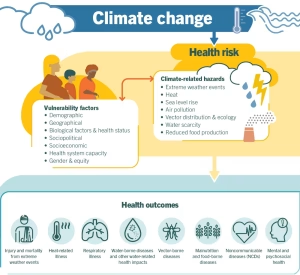Researchers stunned after discovering powerful phenomenon that defies predictions: ‘We were wrong’ – The Cool Down

Report on Arctic Ice Melt and its Implications for Sustainable Development Goals
Introduction: A New Discovery in the Context of SDG 13 and SDG 14
Recent research reveals an unforeseen consequence of rising global temperatures, a primary concern of Sustainable Development Goal 13 (Climate Action). The rapid melting of Arctic sea ice has enabled a significant increase in nitrogen fixation, a process with direct implications for Sustainable Development Goal 14 (Life Below Water). A study published in Communications Earth & Environment details how microbial activity under melting ice is converting atmospheric nitrogen into ammonium, potentially altering the productivity of Arctic marine ecosystems.
Key Research Findings
The study challenges previous assumptions about the conditions required for nitrogen fixation in polar regions. Key findings include:
- Contrary to prior belief, nitrogen fixation by microbes can and does occur under Arctic sea ice.
- The process is driven by the changing conditions resulting from ice melt, which creates a more favorable environment for these specific microorganisms.
- This newly discovered phenomenon suggests that as climate change accelerates ice loss, the rate of nitrogen fixation in the Arctic Ocean may increase substantially.
Implications for SDG 14: Life Below Water
The increase in nitrogen fixation, a key nutrient for marine life, could have several profound effects on the Arctic ecosystem, directly relating to the targets of SDG 14.
- Enhanced Primary Productivity: The increased availability of ammonium is expected to promote the growth of algae, the base of the marine food web. This could enhance the ocean’s capacity to support diverse marine species.
- Strengthened Marine Food Webs: A boost in algae production provides a larger food source for various marine organisms, potentially strengthening the entire food chain from plankton to larger predators.
- Increased Carbon Sequestration: Greater algae biomass could lead to higher absorption of atmospheric carbon dioxide (CO2) by the Arctic Ocean. This natural carbon sink mechanism contributes to climate mitigation efforts, aligning with both SDG 14 and SDG 13.
Researchers caution that biological systems are complex, and while these developments appear beneficial, other mechanisms could counteract these effects.
The Overarching Challenge of SDG 13: Climate Action
While the potential for increased marine productivity is notable, it is a direct result of the climate crisis, which poses severe threats to global sustainability.
- Sea-Level Rise: The primary driver, Arctic ice melt, is a major contributor to global sea-level rise, threatening coastal communities and ecosystems worldwide, a challenge addressed by SDG 11 (Sustainable Cities and Communities) and SDG 13.
- Disruption of Global Systems: The loss of Arctic ice disrupts ocean currents and weather patterns, increasing the frequency and severity of extreme weather events globally.
Global Mitigation Efforts and Future Research
Addressing the root cause of Arctic ice loss remains a global priority. International efforts are focused on achieving the targets of SDG 13 and SDG 7 (Affordable and Clean Energy).
- International Agreements: Frameworks like the Paris Agreement aim to unite countries in reducing carbon emissions and transitioning toward net-zero economies.
- Transition to Renewable Energy: A global shift to renewable energy sources is critical to cutting the carbon pollution that drives rising temperatures and ice melt.
Researchers emphasize the necessity of incorporating this new understanding of nitrogen fixation into climate models. Accurately predicting the future of the Arctic Ocean requires a comprehensive view of all biogeochemical processes, ensuring that strategies to protect marine life (SDG 14) and combat climate change (SDG 13) are based on the most current science.
Analysis of Sustainable Development Goals in the Article
1. Which SDGs are addressed or connected to the issues highlighted in the article?
- SDG 13: Climate Action: The article’s central theme is the impact of rising global temperatures, a core concern of SDG 13. It discusses the melting of Arctic ice sheets as a direct consequence of climate change and mentions international efforts like the Paris Agreement to combat it by reducing carbon emissions.
- SDG 14: Life Below Water: The article directly addresses marine ecosystems. It explores how the melting of Arctic ice affects marine life through the process of nitrogen fixation, which could boost algae growth and support the marine food web. It also touches upon the ocean’s role in absorbing CO2.
- SDG 7: Affordable and Clean Energy: As a solution to the problem of rising temperatures, the article explicitly mentions the “transition to renewable energy resources” that many countries are undertaking to cut carbon pollution.
- SDG 11: Sustainable Cities and Communities: The article highlights the risks to human settlements by mentioning that rising sea levels could put coastal communities at a “higher risk of flooding, leading to the potential displacement of millions of people across the planet.”
2. What specific targets under those SDGs can be identified based on the article’s content?
-
SDG 13: Climate Action
- Target 13.1: Strengthen resilience and adaptive capacity to climate-related hazards and natural disasters in all countries. The article points to this target by discussing the negative impacts of ice melt, such as rising sea levels, disruption of weather patterns, “more severe storms,” and increased flooding risk for coastal communities.
- Target 13.2: Integrate climate change measures into national policies, strategies and planning. This is directly referenced when the article mentions international initiatives like the “Paris Agreement,” which has set goals for countries to “reduce emissions” and “achieve net-zero pollution.”
-
SDG 14: Life Below Water
- Target 14.2: By 2020, sustainably manage and protect marine and coastal ecosystems to avoid significant adverse impacts. The article’s focus on how Arctic ice melt is “influencing the delicate balance of the planet’s largest bodies of water” and changing how the “Arctic Ocean functions” relates directly to managing and understanding impacts on marine ecosystems.
- Target 14.3: Minimize and address the impacts of ocean acidification, including through enhanced scientific cooperation at all levels. The article mentions that increased algae production could lead the Arctic Ocean to “absorb more carbon dioxide.” The research study itself, conducted by researchers from the University of Copenhagen, is an example of the scientific cooperation needed to understand these processes.
-
SDG 7: Affordable and Clean Energy
- Target 7.2: By 2030, increase substantially the share of renewable energy in the global energy mix. The article supports this by stating that a key action being taken to address rising temperatures is promoting the “transition to renewable energy resources.”
-
SDG 11: Sustainable Cities and Communities
- Target 11.5: By 2030, significantly reduce the number of deaths and the number of people affected… by disasters. The article connects to this target by warning that rising sea levels could lead to flooding in coastal communities and the “potential displacement of millions of people.”
3. Are there any indicators mentioned or implied in the article that can be used to measure progress towards the identified targets?
- Rate of global temperature rise: The article opens by stating that “Rising global temperatures” are the primary driver of the issues discussed. This is a key indicator for climate change.
- Volume of Arctic ice melt: The “rapid melting of ice sheets in the Arctic” is a direct physical indicator of climate change’s impact.
- Rate of sea-level rise: The article explicitly mentions that “sea levels are rising at an alarming rate” and provides a specific projection for India, making it a measurable indicator of climate impact.
- Levels of nitrogen fixation in the Arctic Ocean: The core scientific discovery is the increase in nitrogen fixation. This is a specific, measurable biogeochemical process that can be monitored.
- Algae biomass/production: The article suggests that increased nitrogen fixation could lead to a “boost for the production of algae.” Measuring algae biomass would be an indicator of this ecosystem change.
- Carbon dioxide absorption by the ocean: The potential for the Arctic Ocean to “absorb more carbon dioxide” is a measurable indicator related to the global carbon cycle and climate feedback loops.
- Greenhouse gas emissions levels: The mention of countries setting goals to “reduce emissions” and achieve “net-zero pollution” directly refers to the primary indicator for tracking progress on climate action.
- Share of renewable energy in the energy mix: The “transition to renewable energy resources” implies measuring the proportion of energy generated from renewable versus non-renewable sources.
SDGs, Targets, and Indicators Summary
| SDGs | Targets | Indicators |
|---|---|---|
| SDG 13: Climate Action |
13.1: Strengthen resilience to climate-related hazards.
13.2: Integrate climate change measures into policies. |
– Rising global temperatures – Rate of Arctic ice melt – Rising sea levels – Frequency of severe storms – National greenhouse gas emissions levels – Pledges to achieve net-zero pollution |
| SDG 14: Life Below Water |
14.2: Protect marine and coastal ecosystems.
14.3: Minimize ocean acidification. |
– Levels of nitrogen fixation in the Arctic – Amount of algae production/biomass – Rate of carbon dioxide absorption by the ocean |
| SDG 7: Affordable and Clean Energy | 7.2: Increase the share of renewable energy. | – Rate of transition to renewable energy resources |
| SDG 11: Sustainable Cities and Communities | 11.5: Reduce the number of people affected by disasters. |
– Number of people in coastal communities at risk of flooding – Number of people potentially displaced by rising sea levels |
Source: thecooldown.com
What is Your Reaction?
 Like
0
Like
0
 Dislike
0
Dislike
0
 Love
0
Love
0
 Funny
0
Funny
0
 Angry
0
Angry
0
 Sad
0
Sad
0
 Wow
0
Wow
0
















































:focal(1500,1000)/https://media.globalcitizen.org/a6/9a/a69a4720-d8a1-4715-b596-18738d03c05c/rotary_polio_hero_image.jpg?#)







/countries/sri-lanka/photo-credit---dmc-sri-lanka.tmb-1200v.jpg?sfvrsn=dc298bcc_1#)

















